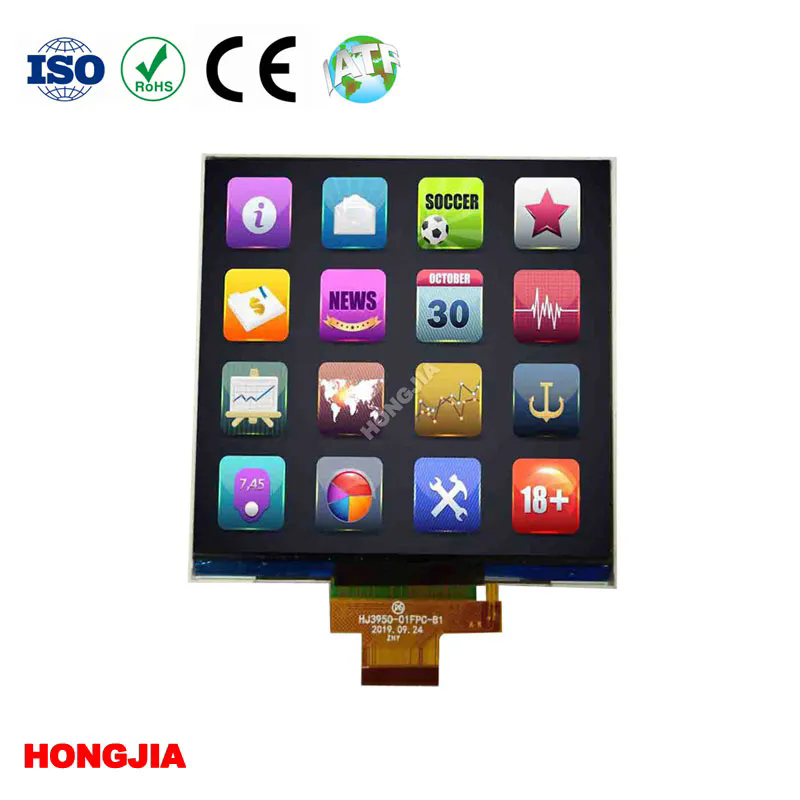Everything You Should Know About Square LCDs
2024-10-30
1. What Is a Square LCD?
A Square LCD (Liquid Crystal Display) is a display screen that features a 1:1 aspect ratio, meaning its height and width are the same, forming a perfect square shape. Unlike the more common rectangular displays, square LCDs are used in niche applications where unique screen proportions are required for design aesthetics, space constraints, or specific functions.
2. Where Are Square LCDs Used?
Square LCDs are versatile and can be found in a variety of industries and applications, including:
- Smart home devices: Thermostats, digital clocks, and control panels.
- Retail and advertising: Compact digital signage or point-of-sale displays.
- Wearable tech: Smartwatches and fitness trackers.
- Medical equipment: Monitors and diagnostic tools.
- Industrial interfaces: Machines and control systems with space-limited panels.
3. Why Use a Square LCD Instead of a Rectangular One?
Square LCDs offer specific benefits depending on the use case:
- Space efficiency: In compact devices like smartwatches, the square shape optimizes screen area.
- Unique aesthetics: Designers often choose square screens for a sleek, modern look.
- Simplified UI: Applications like thermostats or dashboards with centered data benefit from symmetry.
- Versatility in display orientations: They allow easier adaptation in both vertical and horizontal layouts.
4. What Are the Key Features of Square LCDs?
Square LCDs share several important characteristics:
- High resolution: Even with small sizes, they offer sharp and clear images.
- Touchscreen support: Many models include capacitive touch panels.
- Wide viewing angles: Ideal for public displays and control panels.
- Energy efficiency: Designed for low power consumption, especially in wearable devices.
- Rugged designs: Some square LCDs are built with weatherproofing and durability for industrial use.
5. What Are the Different Types of Square LCDs?
Several types of square LCDs are available based on the underlying technology:
- TFT LCD: Thin-film transistor displays provide vivid colors and fast response times, ideal for smartwatches.
- OLED displays: Known for deep blacks and high contrast, often used in premium devices.
- E-ink displays: Used in low-power applications like digital price tags.
- IPS panels: Offer better viewing angles and color accuracy for retail or medical interfaces.
6. What Sizes Are Common for Square LCDs?
Square LCDs are typically small to medium in size, ranging from 1.2 inches to 5 inches, with larger screens used in specific applications like kiosks or medical devices. Wearable devices usually feature smaller sizes (1.2–2 inches), while control panels or signage may use larger ones.
7. Are Square LCDs More Expensive Than Rectangular Screens?
Square LCDs can sometimes be more expensive than standard rectangular displays due to their specialized nature and smaller production volumes. However, the price difference largely depends on the screen size, resolution, and features (e.g., touch capability or outdoor durability).
8. How Are Square LCDs Controlled and Programmed?
Like other LCDs, square screens are controlled using microcontrollers or integrated circuits (ICs). Developers typically program them with libraries compatible with interfaces like SPI, I2C, or parallel connections. Devices like smartwatches use embedded operating systems (e.g., RTOS or Android Wear) to drive the square displays efficiently.
9. What Are the Challenges of Using Square LCDs?
Although square LCDs offer unique advantages, they also come with a few challenges:
- Limited availability: Fewer models are available compared to rectangular screens.
- Software adaptation: Some applications need reprogramming to fit a 1:1 layout.
- Higher customization costs: Custom-sized or feature-specific square LCDs may be more expensive to produce.
- Compatibility issues: Not all devices or platforms are optimized for square layouts.
10. What Does the Future Hold for Square LCDs?
As wearable technology, smart home devices, and compact digital interfaces continue to grow in popularity, the demand for square LCDs is likely to increase. Future advancements may include better touch sensitivity, flexible square displays, and even micro-LED technology for brighter, more energy-efficient screens. Designers and engineers are also experimenting with innovative uses for square displays in art installations, interactive exhibits, and AI-integrated products.
Conclusion
Square LCDs are a fascinating blend of functionality and aesthetics, offering unique design opportunities in various industries. Their symmetrical form, efficient use of space, and growing presence in wearables and smart devices make them an essential part of modern technology. While challenges remain, ongoing advancements suggest that square LCDs will play an even greater role in the future of display technologies.



